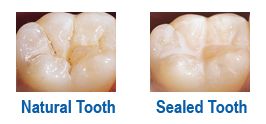 Has your dentist recommended sealants? You may wonder why. Aren’t brushing and flossing enough? Not really. Rough and uneven molars have crevices that trap food and attract cavity-causing bacteria. Sealants act as a barrier on those teeth to prevent germs from doing their dirty work.
Has your dentist recommended sealants? You may wonder why. Aren’t brushing and flossing enough? Not really. Rough and uneven molars have crevices that trap food and attract cavity-causing bacteria. Sealants act as a barrier on those teeth to prevent germs from doing their dirty work.
Are Sealants Effective?
Absolutely. The plain fact is that sealants are the most effective way to prevent cavities on the back teeth. As a matter of fact, sealants prevent 80% of cavities according to the American Dental Association (ADA) who has recommended that all children and teenagers get sealants on permanent teeth.
What Are Sealants?
Dental sealants are thin coatings of plastic that are put on the chewing surfaces of the molars. Having sealants applied is simple, painless and quick. Here is how it works:
- The tooth is carefully clean and dried.
- Cotton is placed around the tooth to protect the gum.
- A solution is put on the tooth to roughen the surface so the sealant will stick.
- The tooth is rinsed, dried and new cotton is placed around it.
- The liquid sealant solution is applied.
- The sealant hardens in just a few seconds.
- The cotton is removed and the sealing is done.
How Long Do Sealants Last?
Some sealants last as long as 10 years. Your dentist will examine the sealants during regular check-ups and can easily repair them by adding more sealing material if necessary.
Who Should Get Sealants?
The most cavity-prone years are between the ages of 6 to 14, when teeth are emerging and daily dental routines are still developing. That is why most dentists follow the recommendation of the ADA and suggest sealants for permanent molars and premolars just as soon as those teeth emerge.
Sometimes, sealants may be prescribed for a child who has baby teeth with deep groves so that those teeth can be healthy and provide good spacing for the permanent teeth. Adults without fillings can also benefit from the extra protection of sealants.
Do Sealants Replace Fluoride?
Actually, sealants work together with fluoride, daily brushing, flossing, and regular dental check-ups to keep your teeth healthy. Fluoride:
- Can repair small areas of decay so they don’t become big cavities.
- Is able to make bacteria less able to cause decay.
- Makes your teeth stronger and more resistant to decay.
How do you know whether you have enough fluoride? Over 60% of Americans have fluoride in their water, including residents of San Francisco. Use filtered water? Some bottled water may have fluoride, but you can also get enough from using any brand of fluoridated toothpaste.
Are Sealants Safe?
In 2016, the ADA and the American Academy of Pediatric Dentistry (AAPD) carefully reviewed safety and efficacy of sealants. They concluded that:
- Sealants reduce the risk of cavities on molars by 80%
- Sealants are completely safe for adults and children.
They acknowledged that sealants give a very low level (.009 ng) of bisphenol A (BPA) exposure. However, that exposure is considered very safe because by comparison:
- Breathing normal air has 100 times as much BPA exposure (8 ng).
- Touching a receipt from a store has 20,000 times as much BPA exposure (138 ng)
Does Insurance Pay for Sealants?
Because sealants are such effective preventative care for teeth, many insurance companies will cover the cost. Check with your insurance carrier to find out if sealants are covered under your plan.
You probably know that keeping your teeth healthy includes a good daily dental regimen, adequite fluoride, regular dental cleanings, and check-ups. Add to that list getting dental sealants which will help those back molars stay cavity-free.